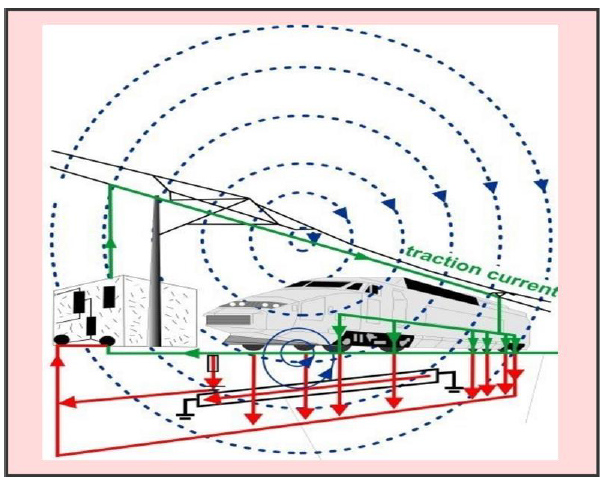Advancing Next-Gen Networks with MIMO Channel Capacity at 300 GHz
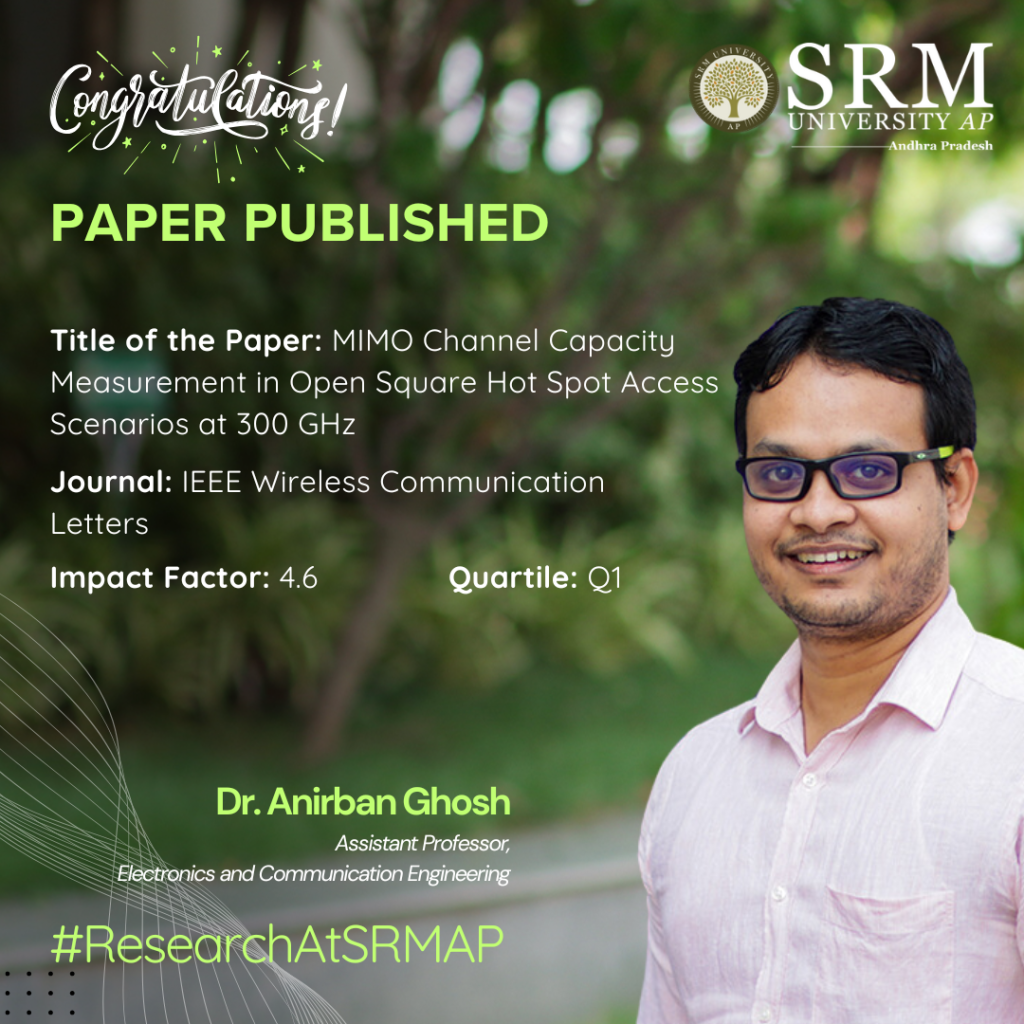
The Department of Electronics and Communication Engineering is pleased to announce the publication of a significant research paper by Dr Anirbhan Ghosh, Assistant Professor, exploring MIMO channel capacity at high frequencies (300 GHz), which holds great potential for beyond 5G and 6G networks. The paper “MIMO Channel Capacity Measurement in Open Square Hot Spot Access Scenarios at 300 GHz” published in the Q1 journal IEEE Wireless Communication Letters, investigates data transmission in three different line-of-sight (LoS) scenarios and contributes to building the next generation of communication networks, which will have a significant positive impact on society by improving connectivity, supporting technological advancements, and promoting economic development.
Abstract
This letter explores the possibility and effectiveness of using multiple communication paths for futuristic outdoor networks, focusing on three scenarios: clear line-of-sight (LoS), partially obstructed line-of-sight (OLoS), and completely blocked line-of-sight (NLoS). A study was conducted at a high frequency of 300 GHz to measure how many useful communication paths are available for transmitting data simultaneously. Based on the results, the average data transmission capacity for these paths was calculated, both with and without the help of passive reflecting surfaces (PRS). The findings show that using multiple antennas significantly boosts the average data capacity, and PRS further enhances this improvement.
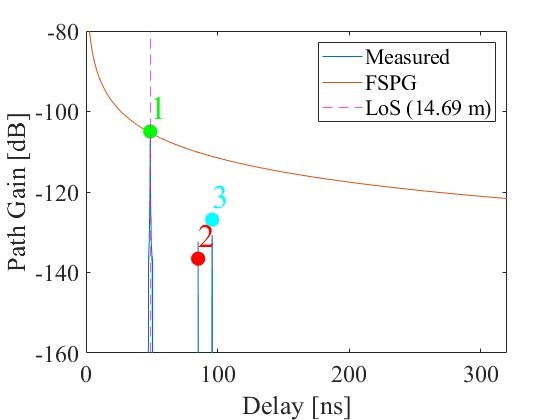
Practical Implementation of the Research
The results align with the design of high-frequency, ultra-high-speed, low-latency, reliable communication envisioned for several futuristic applications beyond 5G and 6G Networks.
Collaborations
Prof. Minseok Kim, Professor, Faculty of Engineering, Course of Electrical and Electronics Engineering, Niigata University, Japan.
Dr Ghosh plans to extend his efforts to other communication scenarios for a similar study. He opines that generating appropriate channel models, coverage design, etc., for the explored scenario would also be an exciting study.
- Published in Departmental News, ECE NEWS, News, Research News
SMAFS Technology Gets Patented
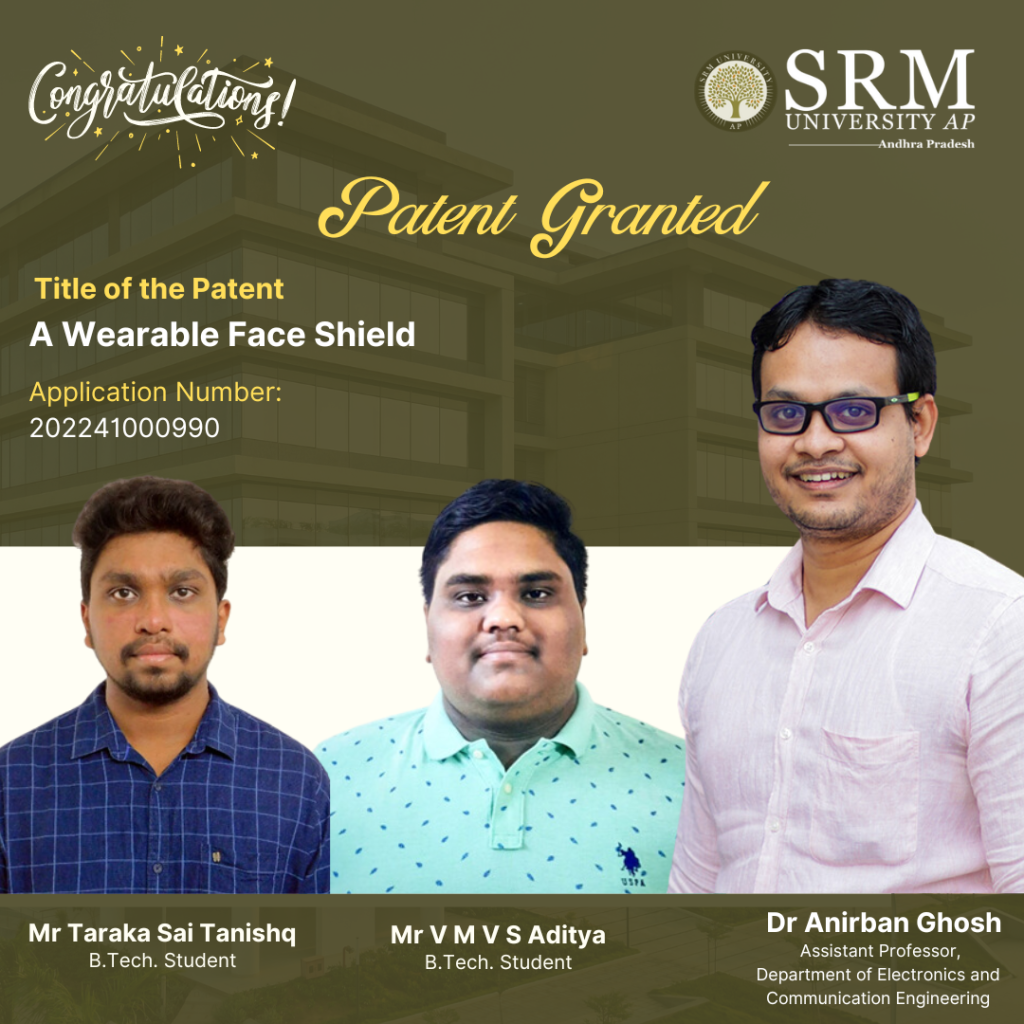
Dr Anirban Ghosh and his BTech students, Mr Taraka Sai Tanishq Chebrolu and Mr V.M.V.S. Aditya from his department, have come up with a pathbreaking innovation where a Smart Face Shield (SMAFS) helps detect a virus and reminds the wearer to maintain a safe distance. This innovation, patented under the Indian Patent Office Journal, with application number-202241000990 , marks a milestone step towards public health and safety.
Abstract:
The recent spurt of corona virus has wreaked havoc across the globe and led to huge loss of human lives. An intelligent system with innovative technologies can be implemented to address the rapid spread of the deadly virus. The wearable face shield that can not only help to maintain appropriate social distancing in a crowded place but also to identify a person with preliminary symptoms of corona virus. It is designed as a technically improved face shield to maintain social distancing by appropriate use of proximity sensor and to measure temperature of the wearer by using contact temperature sensor. LED’s and buzzer are placed strategically to alert people via visual and audio signals respectively. Such precautionary detection and proximity alert prototype can prove instrumental in early diagnosis and isolation aiding in crowd management and free movement in places of social gathering.
Practical Implementation of the Patent:
Such precautionary detection and proximity alert prototype can prove instrumental in early diagnosis and isolation aiding in crowd management and free movement in places of social gathering. Hence, wearable face shield ensures adequate separation between persons and facilitates temperature monitoring and early disease detection.
Future Research Plans:
Future research plans are to further improve the capability of the existing prototype for example integration of oxygen saturation measurement, Heartbeat, Blood pleasure, Temperature, Location, etc of the user. In the event of an emergency or critical drop in any of the vitals, the system can automatically alert the local hospital, ambulance service, and relatives.

- Published in CSE NEWS, Departmental News, ECE NEWS, News, Research News
From Concept to Reality: The Promising Future of AlN-GDC-HEMT in Electronics
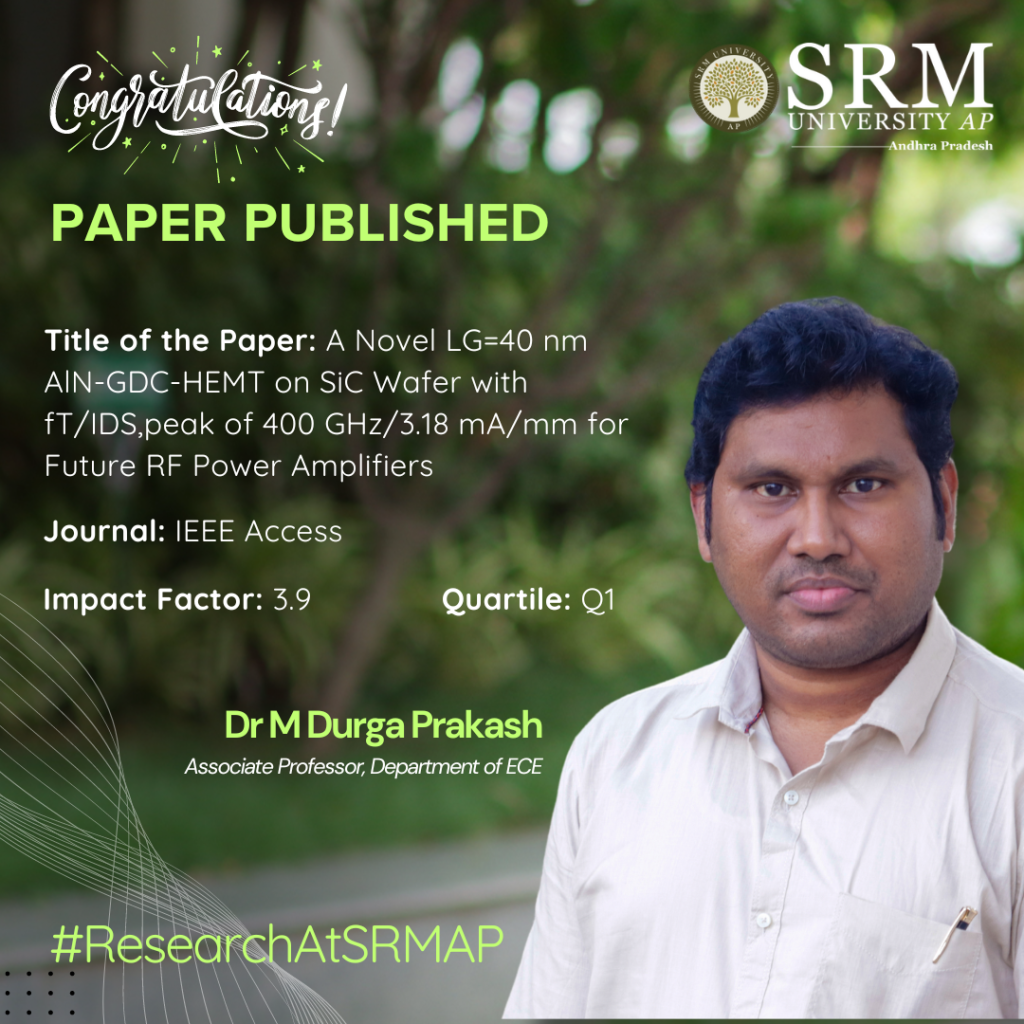
The Department of Electronics and Communication Engineering, SRM University-AP, is pleased to announce that Assistant Professor Dr Durga Prakash has published a noteworthy research paper titled “A Novel LG=40 nm AlN-GDC-HEMT on SiC Wafer with fT/IDS,peak of 400 GHz/3.18 mA/mm for Future RF Power Amplifiers.” This accomplishment reflects Dr Durga Prakash’s expertise and dedication to advancing research in the field and further enriching the academic contributions of the varsity.
Abstract:
This study presents the initial RF/DC performance of innovative AlN/GaN/Graded-AlGaN/GaN double-channel HEMT (AlN-GDC-HEMT) on SiC wafer. Traditional AlGaN/GaN/Graded-AlGaN/GaN double-channel HEMTs (AlGaN-GDC-HEMT) and the AlN-GDC-HEMT are compared. Both devices form two quantum wells, resulting in prominent double peaks in transconductance and cut-off frequency graphs, demonstrating efficient inter-channel communication. AlN-GDC-HEMT and AlGaN-GDC-HEMT are compared based on gate recess length (LR) and top barrier thickness. Gate lengths (LG) are also used to study HEMT scaling. Additionally, gate engineering and lateral scaling affect both devices’ DC/RF behaviour. Based on rigorous comparison investigation, the AlN-GDC-HEMT outperforms the AlGaN-GDC-HEMT due to its higher polarization (spontaneous) density and larger bandgap. The optimized AlN-GDC-HEMT with LG = 40 nm, LGS = 250 nm, and LGD = 400 nm has high performance, with transconductance (GM) values of 203.1 and 787.5 mS/mm at two peaks, IDS_peak of 1.97 A/mm, IDS_sat of 3.18 A/mm, and the highest fT of 285.1 and 416.8 GHz from the left and right peaks First-stage results suggest AlN-GDC-HEMTs could be used in future RF power amplifiers.
Practical & Social Implications of the Research:
It can be concluded that the AlN-GDC-HEMT that has been proposed is extremely promising, as it possesses remarkable performance and is appealing for power microwave GaN-based HEMT production. This highlights the fact that it is suitable for a broad variety of high-performance applications.
Collaborations:
Department of ECE, Faculty of Science and Technology (IcfaiTech), ICFAI Foundation for Higher Education Hyderabad, Hyderabad-501203, India.
Future Research Plans:
Novel semiconductor device development
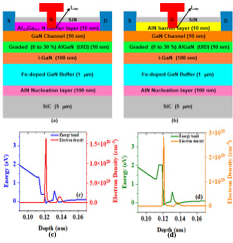
- Published in Departmental News, ECE NEWS, News, Research News
Dr Rupesh Kumar Secures Major Research Grant for Amazon Forest Canopy Mapping Project
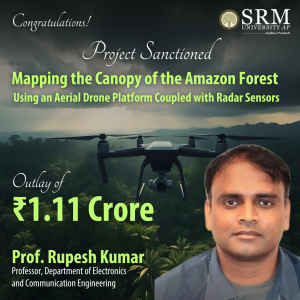 In a groundbreaking development, Dr Rupesh Kumar, a Professor in the Department of Electronics and Communication Engineering, has been awarded a significant project titled “Mapping the Canopy of the Amazon Forest Using an Aerial Drone Platform Coupled with Radar Sensors.” The initiative, funded by the International Peruvian National Research Institute, boasts an impressive outlay of Rs. 1.11 Crores and is set to span over a two-year period.
In a groundbreaking development, Dr Rupesh Kumar, a Professor in the Department of Electronics and Communication Engineering, has been awarded a significant project titled “Mapping the Canopy of the Amazon Forest Using an Aerial Drone Platform Coupled with Radar Sensors.” The initiative, funded by the International Peruvian National Research Institute, boasts an impressive outlay of Rs. 1.11 Crores and is set to span over a two-year period.
The project is spearheaded by Principal Investigator Dr Mark Donny Clemente Arenas, an Associate Professor at the National Technological University of South Lima in Peru. This collaboration aims to enhance the understanding of the Amazon’s intricate canopy structure and promote conservation efforts through innovative technology.
In recognition of this notable achievement, SRM University-AP proudly congratulated Dr Kumar and highlighted the significant impact this project could have on environmental research and sustainability. The university’s support underscores its commitment to fostering research initiatives that address global challenges, encouraging faculty members to pursue innovative solutions through collaboration and the application of cutting-edge technology.
This initiative marks a significant milestone in international research collaboration, leveraging technology to address critical environmental challenges in one of the world’s most vital ecosystems.
A Brief Description of the Project
This project facilitates the mapping of the Amazon forest in Peru. An integrated approach of advanced sensors such as LiDAR, Millimeter-Wave Radar, Camera, etc. and UAV will achieve this.
This will help assess the Amazon forest’s health in real time by leveraging the ML/AI approaches.
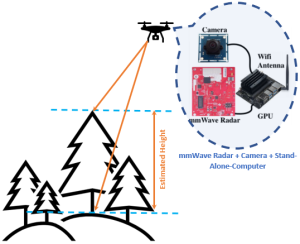
Figure 1: Scheme for height estimation
Explanation of the Research in Layperson’s Terms
The plant/tree generally reflects radio waves and other signals, and this reflection depends on the density of the forest. If a suitable signal processing is applied to the reflected signals, it will provide insight information about the forest profile. Nevertheless, this will help in the quantification of land covered by trees, identifying the location of those trees. Consequently, the tree canopy assessments help in determining the amount and location of impervious cover.
Funding Agency and Amount Sanctioned
National Scientific Research and Advanced Studies Program (PROCIENCIA) of the National Council for Science, Technology and Technological Innovation (CONCYTEC), Peru.
In Spanish: “ Programa Nacional de Investigación Cientifica y Estudios Avanzados (PROCIENCIA), del Consejo Nacional de Ciencia, Tecnología e Innovación
Tecnológica (CONCYTEC), Perú”.
Practical Implementation of the Research or the Social Implications Associated with it
The proposed research work help will help in the assessment of deforestation as well as its impact on climate change and global warming. Not only this, but the research will also contribute to achieving carbon neutrality by 2050!
Collaborations
Universidad Nacional Tecnológica de Lima Sur
Collaborator: Prof. Mark Clement Arenas
Future Research Plans
In future, this work will be extended for infrastructure monitoring. With the boom in real estate, a continuous monitoring system is desired for proper maintenance.
- Published in Departmental News, ECE NEWS, News, Research News
Unveiling Innovations: Dr Ghosh Publishes Findings on 300 GHz Communication Links
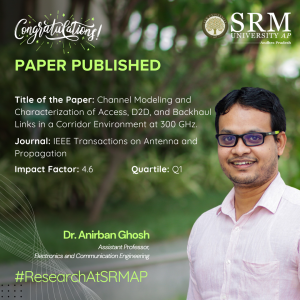 Dr Anirban Ghosh, an esteemed Assistant Professor in the Department of Electronics and Communication Engineering, has recently published a significant research paper titled “Channel Modeling and Characterization of Access, D2D, and Backhaul Links in a Corridor Environment at 300 GHz.” This paper has been featured in the prestigious Q1 Journal, IEEE Transactions on Antenna and Propagation, with an impressive impact factor of 4.6.
Dr Anirban Ghosh, an esteemed Assistant Professor in the Department of Electronics and Communication Engineering, has recently published a significant research paper titled “Channel Modeling and Characterization of Access, D2D, and Backhaul Links in a Corridor Environment at 300 GHz.” This paper has been featured in the prestigious Q1 Journal, IEEE Transactions on Antenna and Propagation, with an impressive impact factor of 4.6.
Dr Ghosh’s research delves into the intricate aspects of channel modelling and characterisation, focusing on access, device-to-device (D2D), and backhaul links within a corridor environment at a high frequency of 300 GHz. This study is poised to make substantial contributions to the field of wireless communication, particularly in enhancing the understanding and development of next-generation communication systems.
The publication in such a renowned journal underscores the quality and impact of Dr. Ghosh’s work, reflecting the cutting-edge research being conducted at SRM University – AP. The university community extends its heartfelt congratulations to Dr. Ghosh for this remarkable achievement and looks forward to his continued contributions to the field of electronics and communication engineering.
Abstract:
This paper presents comprehensive double-directional channel measurements at 300 GHz across various corridor scenarios, including Access, Device-to-Device (D2D), and Backhaul, using an in-house developed channel sounder. The measurements, validated by ray tracing simulations, reveal that while 300 GHz quasi-optical propagation in corridors can be modeled using ray optics, non-trivial propagation phenomena, such as quadruple-bounce reflections, also occur. To accurately model these mechanisms, a quasi-deterministic (QD) channel model combining deterministic and random components is proposed. The QD model results align well with observations, highlighting similar propagation mechanisms for Access and D2D scenarios, while Backhaul scenarios show Line-of-Sight (LoS) impacts from ceiling reflections. These findings are crucial for designing next-generation THz communication systems.
Explanation of Research in Layperson’s Terms
This research contributes to building the next generation of communication networks, which will significantly impact society by improving connectivity, supporting technological advancements, and promoting economic development, and bringing forth several futuristic applications.
Practical Implementation
The results align with the design of high-frequency ultra-high speed, low-latency, reliable communication envisioned for several futuristic applications using beyond 5G and 6G networks.

The measurement scenarios explored in the paper.
Collaborations
Prof. Minseok Kim
Professor, Faculty of Engineering, Course of Electrical and Electronics Engineering
Niigata University, Japan.
e-mail: mskim@eng.niigata-u.ac.jp
Future Research Plans
The efforts would be extended to other communication scenarios for a similar study. Additionally, generating appropriate channel models, coverage design, link budget, etc for the explored and unexplored scenarios would also encompass an interesting study.
- Published in Departmental News, ECE NEWS, News, Research News
AI-Based Remote Fetal Heart Rate Monitoring Published in Leading Journal
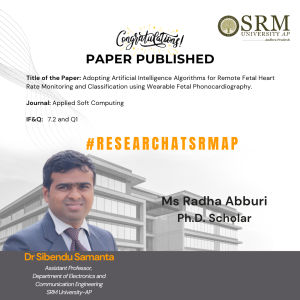 Dr Sibendu Samanta, Assistant Professor in the Department of Electronics and Communication Engineering, and Ms Radha Abburi, a PhD Scholar, have made significant strides in the field of fetal health monitoring. Their paper, titled “Adopting Artificial Intelligence Algorithms for Remote Fetal Heart Rate Monitoring and Classification using Wearable Fetal Phonocardiography,” has been published in the prestigious Q1 Journal, Applied Soft Computing, which boasts an impressive impact factor of 7.2.
Dr Sibendu Samanta, Assistant Professor in the Department of Electronics and Communication Engineering, and Ms Radha Abburi, a PhD Scholar, have made significant strides in the field of fetal health monitoring. Their paper, titled “Adopting Artificial Intelligence Algorithms for Remote Fetal Heart Rate Monitoring and Classification using Wearable Fetal Phonocardiography,” has been published in the prestigious Q1 Journal, Applied Soft Computing, which boasts an impressive impact factor of 7.2.
This pioneering study addresses the critical gaps in the analysis of Fetal Heart Rate (FHR) recordings by leveraging wearable Phonocardiography (PCG) signals and advanced AI algorithms. The primary goal of the research is to achieve accurate classification results through the remote monitoring of fetal heartbeats. Additionally, the study tackles complex issues related to data quantity and the inherent complexity of FHR analysis. Dr Samanta and Ms Abburi’s work represents a significant advancement in the field, promising to enhance the accuracy and reliability of fetal health monitoring, ultimately contributing to better prenatal care.
Abstract of the Research:
Fetal phonocardiography (FPCG) is a non-invasive Fetal Heart Rate (FHR) monitoring technique that can detect vibrations and murmurs in heart sounds. However, acquiring fetal heart sounds from a wearable FPCG device is challenging due to noise and artefacts. This research contributes a resilient solution to overcome the conventional issues by adopting Artificial Intelligence (AI) with FPCG for automated FHR monitoring in an end-to-end manner, named (AI-FHR). Four sequential methodologies were used to ensure reliable and accurate FHR monitoring. The proposed method removes low-frequency noises and high-frequency noises by using Chebyshev II high-pass filters and Enhanced Complete Ensemble Empirical Mode Decomposition with Adaptive Noise (ECEEMDAN) in combination with Phase Shifted Maximal Overlap Discrete Wavelet Transform (PS-MODWT) filters, respectively.
The denoised signals are segmented to reduce complexity, and the segmentation is performed using multi-agent deep Q-learning (MA-DQL). The segmented signal is provided to reduce the redundancies in cardiac cycles using the Artificial Hummingbird Optimization (AHBO) algorithm. The segmented and non-redundant signals are converted into 3D spectrograms using a machine learning algorithm called variational auto-encoder-general adversarial networks (VAE-GAN). The feature extraction and classification are carried out by adopting a hybrid of the bidirectional gated recurrent unit (BiGRU) and the multi-boosted capsule network (MBCapsNet). The proposed method was implemented and simulated using MATLAB R2020a and validated by adopting effective validation metrics.
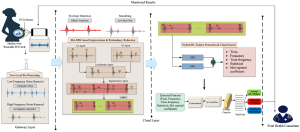
The results demonstrate that the proposed method performed better than the current method with accuracy (81.34%), sensitivity (72%), F1-score (83%), Energy (0.808 J), and complexity index (13.34). Like other optimization methods, AHO needs precise parameter adjustment in order to function well. Its performance may be greatly impacted by the selection of parameters, including population size, exploration rate, and learning rate.
The title of the Research Paper in the Citation Format:
R. Abburi, I. Hatai, R. Jaros, R. Martinek, T. A. Babu, S. A. Babu, S. Samanta, “Adopting artificial intelligence algorithms for remote fetal heart rate monitoring and classification using wearable fetal phonocardiography”, Applied Soft Computing, vol. 165, pp. 112049, 2024, ISSN 1568-4946.
Practical Implementation or the Social Implications Associated with the Research
- Chebyshev filter and EC2EMDAN-PS-MODWT reduce low and high frequency noises.
- MA-DRL and optimization algorithms reduce complexity during classification.
- Machine learning spectrogram conversion to capture time, frequency, and spectral variations.
- Hybrid deep learning algorithms can be used to reduce positive rates.
Collaborations:
- Dr. Indranil Hatai (Signal Processing and FPGA, Mathworks, Bangalore, India)
- Dr. T. Arun Babu (HoD, Dept. of Pediatrics, All India Institute of Medical Sciences (AIIMS), Andhra Pradesh, India)
- Dr. Sharmila Arun Babu, MBBS, MS (HoD, Dept. of Obstetrics and Gynecology, All India Institute of Medical Sciences (AIIMS), Andhra Pradesh, India)
- Dr. Rene Jaros (Dept. of Cybernetics and Biomedical Engineering, Faculty of Electrical Engineering and Computer Science, VSB–Technical University of Ostrava, 708 00, Ostrava, Czechia)
- Prof. Radek Martinek (Dept. of Cybernetics and Biomedical Engineering, Faculty of Electrical Engineering and Computer Science, VSB–Technical University of Ostrava, 708 00, Ostrava, Czechia)
Future Research Plans:
- Design a low cost for continuous fetal heart rate (FHR) monitoring system
- Develop a proper deep learning algorithm to get a proper understanding of fetal’s abnormality.
- Published in Departmental News, ECE NEWS, News, Research News
A Novel Breakthrough on Developing Heterogeneous Small-World LPWANs
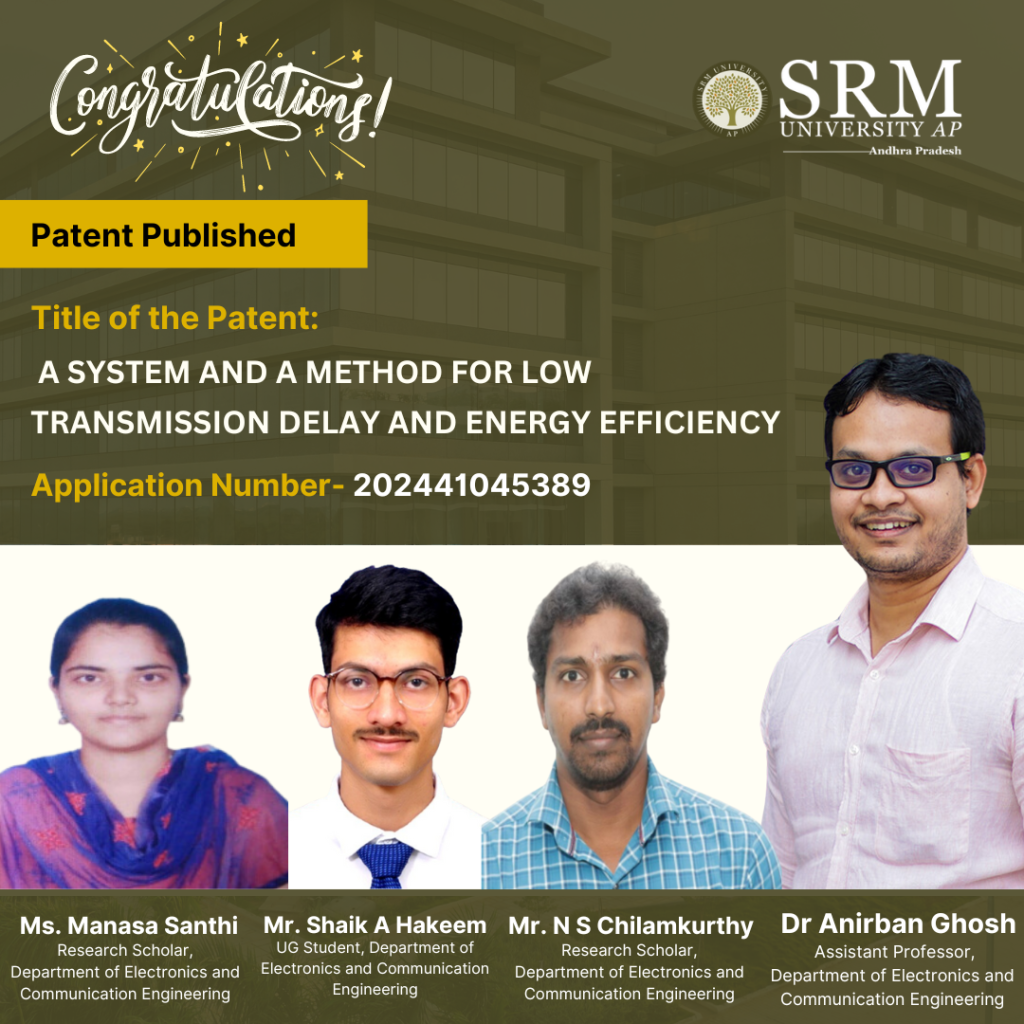
The Department of Electronics and Communication Engineering is delighted to announce that Assistant Professor Dr Anirban Ghosh, PhD scholars Mr Naga Srinivasarao and Ms Manasa Santhi, and BTech student Mr Sk Abdul Hakeem have filed and published their patent, “A System and a Method for Low Transmission Delay and Energy Efficiency,” with Application No: 202441045389. The research cohort has demonstrated groundbreaking research on integrating Small-World Characteristics (SWC) into Low-Power Wide-Area Networks (LPWANs) through Reinforcement Learning.
Abstract
To support the rapid growth of Internet of Things (IoT) applications, networking technologies like Low-Power Wide-Area Networks (LPWANs) are evolving to provide extended network lifespan and broader coverage for Internet of Things Devices (IoDs). These technologies are highly effective when devices remain stationary under static conditions. However, practical IoT applications, ranging from smart cities to mobile health monitoring systems, involve heterogeneous IoDs that move dynamically, leading to changing network topologies. Typically, dynamic networks use multi-hop data transmission schemes for communication, but this method presents challenges such as increased data latency and energy imbalances. To address these issues, this patent introduces a novel approach that integrates recent advancements in social networks, specifically Small-World Characteristics (SWC), into LPWANs using Reinforcement Learning. Specifically, the SWCs are embedded into heterogeneous LPWANs through the Q-learning technique. The performance of the developed heterogeneous Small-World LPWANs is then evaluated in terms of energy efficiency (including the number of alive and dead IoDs, as well as network residual energy) and data transmission delay within the network.
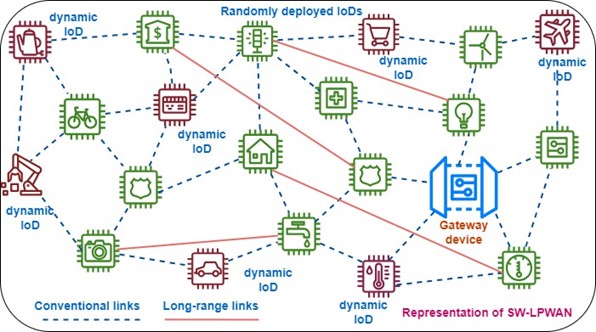
Explanation of Research in Layperson’s Terms
The existing or the present technology moves around the applications that are either static or dynamic in nature, but the current invention considers a realistic IoT application that contains both static and dynamic nodes in the network. However, maintaining low data transmission delay and high network longevity over such a heterogeneous network is a challenge. By integrating SWCs over the developed heterogeneous networks using Q-learning technique helps in minimizing the data transmission delay and improves the network lifetime (energy efficient data transmission).
Practical Implementation of the Research
Applications that contain both static and dynamic nodes, such as smart health care systems, smart environmental monitoring systems, real-time traffic monitoring systems, and smart cities and homes, require less data transmission delay and high network longevity.
Collaborations
- Dr Om Jee Pandey – Assistant Professor, Department of Electronics Engineering, Indian Institute of Technology (BHU) Varanasi
- Dr Satish Kumar Tiwari – Assistant Professor, IIITDM Jabalpur, India
In the next phase of research, the reserach team will work towards investigating how the energy efficiency and other quality of service of smart devices in an IoT setting can be improved if they are completely mobile.
- Published in Departmental News, ECE NEWS, News, Research News
Dr Sunil Publishes Paper on Ethereum Blockchain Framework in IEEE Access
 We are thrilled to announce that Dr Sunil Chinnadurai, Associate Professor in the Department of Electronics and Communication Engineering has published a significant research paper titled “Ethereum Blockchain Framework Enabling Banks to Know Their Customers” in the esteemed journal IEEE Access. In his paper, Dr Chinnadurai explores the innovative applications of Ethereum blockchain technology in enhancing customer verification processes within the banking sector. His research addresses the growing need for robust and secure methods for banks to comply with Know Your Customer (KYC) regulations while ensuring customer privacy and data integrity.
We are thrilled to announce that Dr Sunil Chinnadurai, Associate Professor in the Department of Electronics and Communication Engineering has published a significant research paper titled “Ethereum Blockchain Framework Enabling Banks to Know Their Customers” in the esteemed journal IEEE Access. In his paper, Dr Chinnadurai explores the innovative applications of Ethereum blockchain technology in enhancing customer verification processes within the banking sector. His research addresses the growing need for robust and secure methods for banks to comply with Know Your Customer (KYC) regulations while ensuring customer privacy and data integrity.
This pioneering work contributes to the ongoing discourse on digital transformation in the banking industry and presents a framework that could potentially revolutionise customer onboarding and identity verification practices.
We extend our congratulations to Dr Chinnadurai for this remarkable achievement and look forward to his continued contributions to the field of electrical and electronics engineering. His research not only enhances the academic reputation of SRM University-AP but also paves the way for innovative solutions in the financial sector.
Abstract of the Research
This paper looks at how blockchain technology can improve the Know Your Customer (KYC) process. It aims to make things more open, secure, and unchangeable. Banks can use the Ethereum blockchain to get and keep customer information, which saves time and money. The solution tries to solve problems with KYC procedures making sure banks follow the rules and stop fraud. The central bank will keep a list of all banks and check if they’re doing KYC right. This spread-out approach gives banks a good long-lasting way to bring in new customers.
Explanation of the Research in Layperson’s Terms
Our study seeks to cause a revolution in the Know Your Customer (KYC) process for banks using Ethereum blockchain technology. Current KYC methods take too long, cost too much, and leave room for cheating. Blockchain offers a clear, safe, and unchangeable platform to store customer data letting banks check and confirm identities. This spread-out approach means customers only need to complete the KYC process one time, which saves a lot of time and money for both banks and customers. Also, blockchain’s safety features make sure that private data stays unchanged and safe from people who shouldn’t see it. Our planned system involves the central bank keeping a full list of all banks and watching to make sure they follow KYC rules. In the future, we plan to put our solution on the real Ethereum network and build a working decentralized app. This system promises to make KYC processes faster, safer, and cheaper, giving a strong answer for banks all over the world.
Practical Implementation or the Social Implications associated
Our research puts blockchain tech to work to improve how banks verify customers. This decentralized system gives everyone access to the same current info through a shared record. This cuts down on middlemen and their costs. Smart contracts that run on their own speed up checks with less human involvement. This lowers the chance of data getting out. It makes transactions faster and keeps data safe from changes it shouldn’t have. This new way of checking customers can save money, make customers happier, and follow rules better. It can make people trust banks more by keeping data safer and being more open. It also means banks don’t have to do the same checks over and over, which is better for them and their customers. In the end, our blockchain answer for customer checks aims to make banking safer, smoother, and cheaper. It should also help build more trust in banks overall.
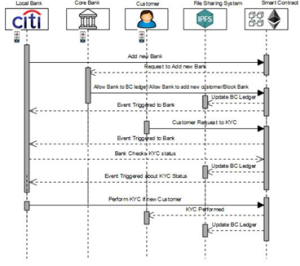
FIGURE 1. Implementation of a blockchain-based KYC process
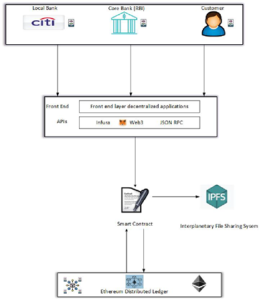
FIGURE 2. Sequential flow diagram illustrating the proposed KYC process using blockchain technology
Future Research Plans
We’re planning to test our idea a lot on the Ethereum network to make sure it works well. We want to build a working DApp that shows our KYC system is doable. We’ll check if people might use it and look at how safe and private it is. By doing this, we hope to make a strong and reliable DApp that’s easy to use, open, safe, and quick. In the end, we want to create something that makes KYC better and sets a new bar for money stuff making banking safer and faster for everyone. Our main goal is to make a system that does not improve how KYC works but also changes how money moves around, making sure banks are safer and work better for people.
- Published in Departmental News, ECE NEWS, News, Research News
Faculty and Students Leads to Patent Publication for Intelligent Shelf Management System
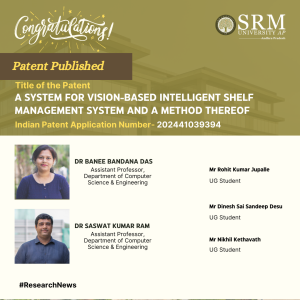 In a groundbreaking collaboration, Dr Banee Bandana Das, Assistant Professor in the Department of Computer Science and Engineering, and Dr Saswat Kumar Ram, Assistant Professor in the Department of Electronics and Communication Engineering, have joined forces with Btech-CSE students Mr Rohit Kumar Jupalle, Mr Dinesh Sai Sandeep Desu, and Mr Nikhil Kethavath to develop and patent an innovative invention.,” The team’s invention, titled “A SYSTEM FOR VISION-BASED INTELLIGENT SHELF MANAGEMENT SYSTEM AND A METHOD THEREOF,” has been officially filed and published with Application Number 202441039394 in the Patent Office Journal. This invention showcases the academic excellence and collaborative spirit within the institution, as faculty members and students work together to push the boundaries of technology and create solutions with real-world impact.
In a groundbreaking collaboration, Dr Banee Bandana Das, Assistant Professor in the Department of Computer Science and Engineering, and Dr Saswat Kumar Ram, Assistant Professor in the Department of Electronics and Communication Engineering, have joined forces with Btech-CSE students Mr Rohit Kumar Jupalle, Mr Dinesh Sai Sandeep Desu, and Mr Nikhil Kethavath to develop and patent an innovative invention.,” The team’s invention, titled “A SYSTEM FOR VISION-BASED INTELLIGENT SHELF MANAGEMENT SYSTEM AND A METHOD THEREOF,” has been officially filed and published with Application Number 202441039394 in the Patent Office Journal. This invention showcases the academic excellence and collaborative spirit within the institution, as faculty members and students work together to push the boundaries of technology and create solutions with real-world impact.
This significant achievement not only highlights the creativity and dedication of the individuals involved but also underscores the institution’s commitment to fostering a culture of innovation and research. The publication of this invention paves the way for further exploration and development in the field of intelligent shelf management systems, demonstrating the potential for transformative contributions to the industry.
Abstract
This research offers the best solution to improve the business in the retail realm, maintaining On- Shelf Availability (OSA) is vital for customer satisfaction and profitability. Traditional OSA methods face accuracy challenges, prompting a shift to deep learning models like YOLO and CNN. However, data quality remains a hurdle. This research introduces OSA, a novel semi-supervised approach merging ’semi-supervised learning’ and ’on-shelf availability’ with YOLO. It reduces human effort and computation time, focusing on efficient empty-shelf detection. Implementing a Vision-Based Intelligent Shelf Management System empowers retailers with real-time insights, revolutionizing decision-making. The model is optimized for diverse devices and provides practical solutions for efficient retail operations. Balancing model complexity, size, latency, and accuracy, the research paves the way for an advanced, data-driven shelf management approach, contributing to improved shopping experiences and business profitability
Practical Implementation and the Social Implications Associated
1. The present invention is a time-saving method in maintaining the stocks.
2. The use Vision-Based Intelligent Shelf-Management System provide a well alternative in reducing the labor efforts.
3. The system will help in terms of self-management system using machine learning techniques to optimize restocking decisions.
The present invention can be used in shopping malls and business areas for enhancing customer experiences and business and few application areas are:
• Smart City and smart Village
This technique and system can reduce the human efforts in identifying vacant slots for items in business areas and provides necessary inputs to fill the same within a time frame.
• Automobile Industry
The system can be easily integrated with the showrooms to identify the empty spaces and inform to get it fill with products.
Collaborations
SRM AP Faculties and UROP Students
Future research plan
In the future, different deep learning and machine learning methods can be merged to explore better performance in identifying overlapping objects.
- Published in CSE NEWS, Departmental News, ECE NEWS, News, Research News
Revolutionising Cattle Safety
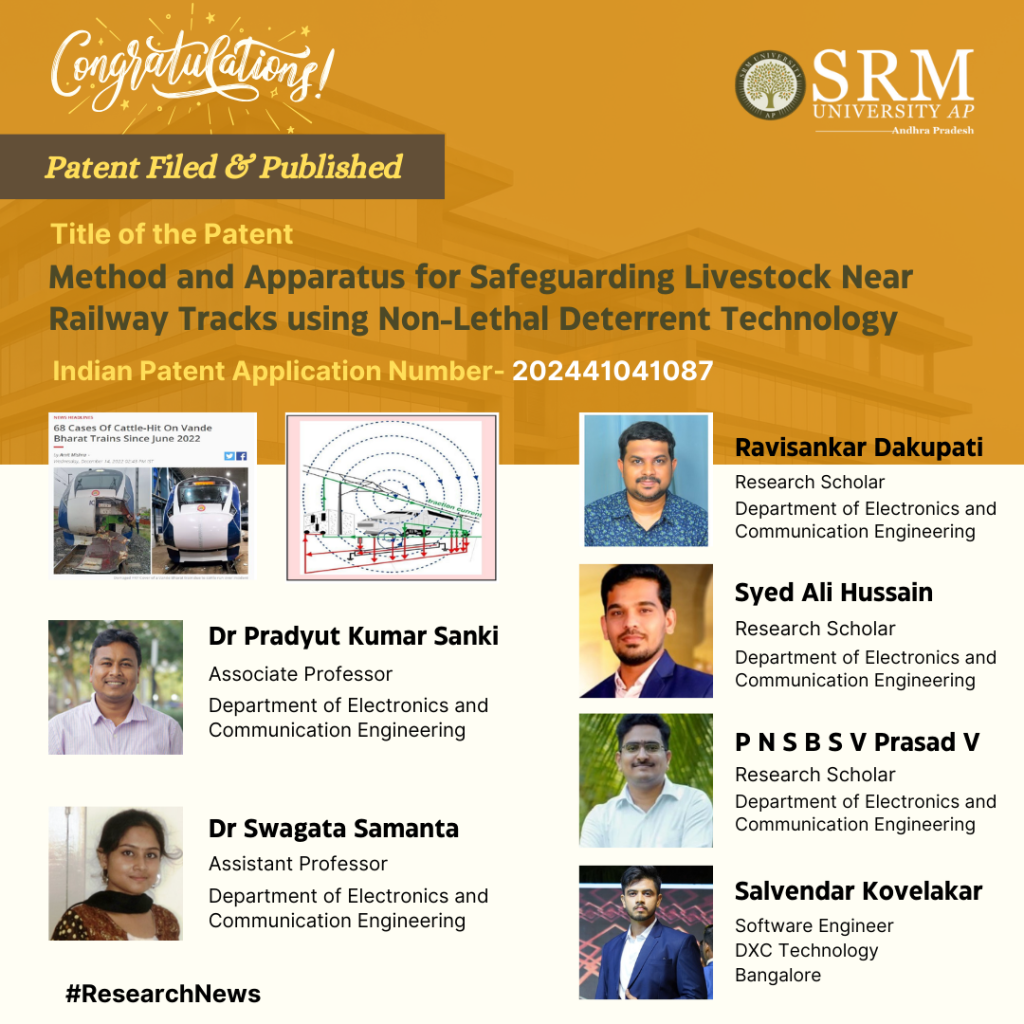
The Department of Electrical and Communication Engineering at SRM University-AP is delighted to announce the publication of a patent by its faculty, including Associate Professor Dr Pradyut Kumar Sanki and Assistant Professor Dr Swagata Samanta, along with research scholars Ravisankar Dakupati, Syed Ali Hussain, and P N S B S V Prasad V. The patent, titled “Method and Apparatus for Safeguarding Livestock Near Railway Tracks using Non-Lethal Deterrent Technology,” has introduced a groundbreaking solution that helps prevent accidents of wandering cattle. This innovative technology promises to protect livestock and minimise economic losses for cattle owners while championing the advancement of technology in countries like India.
Abstract:
Nowadays we have been hearing that Vandebharat express train hits cow, causing damage to both railways and cattle owners. We need to find a solution to this problem. These issues shouldn’t be hurdle for the growth of technology for developing countries like india. The technology we are going to use is a belt is worn by a cow. When the cow tries to cross near railway track it receives a Non-Lethal shock, makes the cow to scare and move back. All this circuit is operated with 7.4V DC
Practical implementation:
The practical implementation of the Anti-Track Cattle Band involves equipping cows with the device to prevent accidents near railway tracks. By detecting magnetic fields and delivering non-lethal shocks, the device ensures the safety of both the cattle and the railway infrastructure. This implementation can significantly reduce the risk of collisions and protect valuable livestock.
From a social perspective, the invention has several implications. It addresses the safety concerns of both animals and humans by preventing accidents and minimizing potential harm. By safeguarding livestock near railway tracks, the technology contributes to animal welfare and reduces economic losses for cattle owners. Additionally, the device promotes a more humane and proactive approach to mitigating risks associated with animal-human interactions in railway environments.
Collaborations:
The research on the Anti-Track Cattle Band involved collaboration among a team of inventors with diverse expertise:
Ravisankar Dakupati – Research Scholar at SRM University-AP
Salvendar Kovelakar – Software Engineer at DXC Technology, Bangalore
Syed Ali Hussain – Research Scholar at SRM University-AP
P N S B S V Prasad V – Research Scholar at SRM University-AP
Dr Pradyut Kumar Sanki – Associate Professor at SRM University-AP
Dr Swagata Samanta – Assistant Professor at SRM University-AP
This collaborative effort brought together individuals with backgrounds in research, software engineering, and academia to develop and implement the innovative Anti-Track Cattle Band technology.
Future Research Plans:
In future research for patent publication regarding “Apparatus and Method for Railway Livestock Protection,” the focus will likely be on enhancing sensor technology to detect animals more accurately over longer distances and in various conditions. This could involve integrating artificial intelligence and machine learning for improved detection and reducing false alarms. Additionally, there may be efforts to develop systems for remote monitoring and control, enabling real-time adjustments from a central location. Adaptability to different environments, collaboration for standardized protocols, cost-effectiveness, and assessing environmental impacts will also be key areas of interest. Overall, future research aims to create more effective, efficient, and sustainable solutions for protecting livestock around railway tracks
- Published in Departmental News, ECE NEWS, News, Research News



